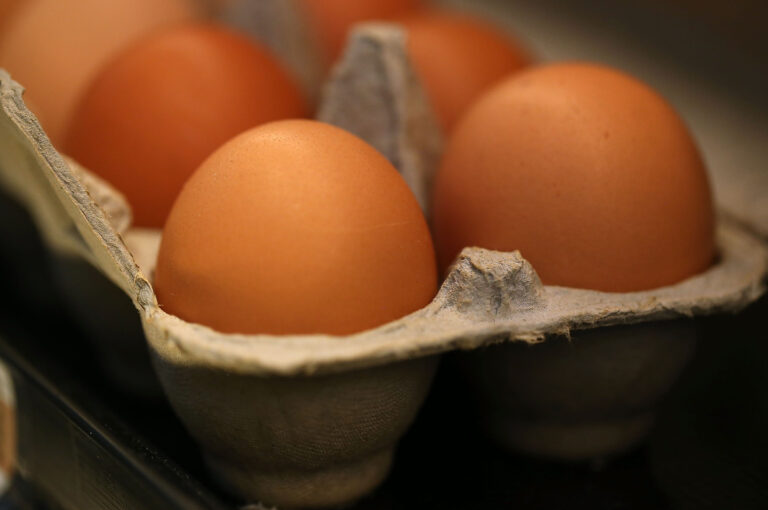Maybe you’ve seen the funny internet memes about high egg prices? Like the one where a guy gets on his knees to propose, but instead of a ring, he brings out a dozen precious eggs!
Well, egg prices have finally begun to decline. “We’re seeing wholesale prices start to come down,” says David Ortega, a food economist at Michigan State University. The wholesale price of a dozen eggs in the midwest market dropped by 58 cents to $3.29 a dozen at the end of January, according to USDA data.
There is a lag between a drop in wholesale prices and what we pay at the grocery store, Ortega says, but we can expect some relief soon. I’ve already seen prices fall at my local supermarket.
However, the days of $1.50 a dozen may not return anytime soon. That’s partly because inflation has driven up the cost of feed, transportation and labor. But the biggest factor impacting egg prices is the outbreak of bird flu – highly pathogenic avian influenza (HAPI) – which can spread quickly from flock to flock and is lethal in chickens. The CDC estimates more than 58 million birds have died or been culled because of the current outbreak.
The virus has caused an acute “shock” to the egg supply, Ortega says. And “there’s a lot of uncertainty about how much longer this outbreak will continue.” Amid such unpredictability, Ortega says prices are sticky. “They tend to rise quickly, but take much longer to come down.”
Avian flu isn’t new, but scientists say this current outbreak is more widespread and more lethal than the last outbreak in 2015. It’s been detected in wild birds in all 50 states. Typically, wild birds don’t get sick from the virus, but the strain circulating now appears more virulent. “We’re seeing symptoms and we’re seeing mortality in some of the wild birds,” says poultry scientist Phillip Clauer of Penn State College of Agricultural Sciences. “This time around, it’s more deadly, Clauer says.
The latest CDC data shows the avian flu has been detected in a range of species, including black vultures and geese. There’s also a few recent reports of infection in great-horned owls, red-tailed hawks and bald eagles.
Since the avian flu began circulating last year, there have been outbreaks at poultry operations in 47 states. Outbreaks typically begin when wild birds, such as geese, infect chickens, turkeys or other waterfowl in commercial flocks or backyard flocks. Once an infection is found in any flock, the USDA euthanizes the whole flock. “This highly pathogenic disease is very deadly,” says Clauer. “So the whole idea is to get on top of it and help the birds die in a humane manner and not allow the disease to continue to spread,” he explains.
In recent years farmers have stepped up biosecurity measures to protect their flocks. “You’re trying to build barriers,” explains Clauer. For example, since the virus can spread through bird poop or feathers, workers take precautions to keep their hands, clothes and shoes clean. Tools and equipment should be disinfected, too.
Farmers try to discourage waterfowl from landing in fields near their poultry houses. “You’re setting a parameter around your poultry to protect them,” Clauer says.
The virus poses a “low risk” to people, according to the CDC. The agency says avian flu viruses “usually do not infect people,” though last spring, the CDC reported the infection of one person in Colorado who had been in contact with infected poultry. The person reported fatigue and was treated with an antiviral medication.
So, when will the outbreak end?
“We don’t know,” says Dr. Yuko Sato, a veterinarian at Iowa State University. “We hope we’re somewhere in the middle or hoping towards the end,” she says. Sato says killing off infected flocks takes an emotional toll on farmers. “Nobody likes to be, you know, depopulating, euthanizing birds,” she says. Then, egg producers must invest in rebuilding their flocks beginning with chicks. “It takes about somewhere between 16 to 18 weeks for birds to mature to that point to start laying eggs,” Sato explains. So, there’s a lag time to rebuild supplies of eggs.
“Our stock is still down about 5%, right now,” explains Emily Metz, president of the American Egg Board. But she says farmers are focused on a quick recovery and they continue to invest in prevention strategies to fend off avian flu. “I have farmers that have put in laser light systems to prevent migratory birds from landing on their barns,” she explains. “I have farms that are bussing in their workers to minimize truck traffic,” and lower the risk of contamination. The hope is that these efforts make the operations more resilient.
“Egg prices are trending downward for sure,” Metz says. “I think there’s relief in sight.”
9(MDM5MjE5NTg1MDE1Mjk1MTM5NjlkMzI1ZQ000))

